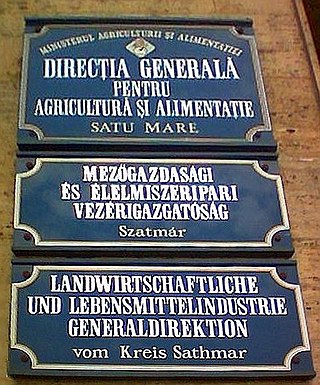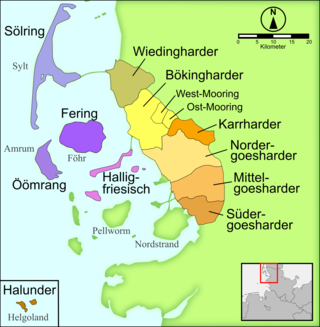The Germanic umlaut is a type of linguistic umlaut in which a back vowel changes to the associated front vowel (fronting) or a front vowel becomes closer to (raising) when the following syllable contains, , or.
Sona is an international auxiliary language created by Kenneth Searight and described in a book he published in 1935. The word Sona in the language itself means "auxiliary neutral thing". Contrary to popular belief, the similarity to the English word 'sonorous' is superficial.

In linguistics, agglutination is a morphological process in which words are formed by stringing together morphemes, each of which corresponds to a single syntactic feature. Languages that use agglutination widely are called agglutinative languages. For example, in the agglutinative language of Turkish, the word evlerinizden consists of the morphemes ev-ler-iniz-den, literally translated morpheme-by-morpheme as house-plural-your(plural)-from. Agglutinative languages are often contrasted with isolating languages, in which words are monomorphemic, and fusional languages, in which words can be complex, but morphemes may correspond to multiple features.
This article outlines the grammar of the Dutch language, which shares strong similarities with German grammar and also, to a lesser degree, with English grammar.

Föhr Frisian, or Fering, is the dialect of North Frisian spoken on the island of Föhr in the German region of North Frisia. Fering refers to the Fering Frisian name of Föhr, Feer. Together with the Öömrang, Söl'ring, and Heligolandic dialects, it forms part of the insular group of North Frisian dialects and it is very similar to Öömrang.
The Germanic language family is one of the language groups that resulted from the breakup of Proto-Indo-European (PIE). It in turn divided into North, West and East Germanic groups, and ultimately produced a large group of mediaeval and modern languages, most importantly: Danish, Norwegian, and Swedish (North); English, Dutch and German (West); and Gothic.
In phonology, epenthesis means the addition of one or more sounds to a word, especially in the beginning syllable (prothesis) or in the ending syllable (paragoge) or in-between two syllabic sounds in a word. The word epenthesis comes from epi- "in addition to" and en- "in" and thesis "putting". Epenthesis may be divided into two types: excrescence for the addition of a consonant, and for the addition of a vowel, svarabhakti or alternatively anaptyxis. The opposite process, where one or more sounds are removed, is referred to as elision.
Danish grammar is either the study of the grammar of the Danish language, or the grammatical system itself of the Danish language. Danish is often described as having ten word classes: verbs, nouns, pronouns, numerals, adjectives, adverbs, articles, prepositions, conjunctions, and interjections. The grammar is mostly suffixing. This article focuses on Standard Danish.
Swedish is descended from Old Norse. Compared to its progenitor, Swedish grammar is much less characterized by inflection. Modern Swedish has two genders and no longer conjugates verbs based on person or number. Its nouns have lost the morphological distinction between nominative and accusative cases that denoted grammatical subject and object in Old Norse in favor of marking by word order. Swedish uses some inflection with nouns, adjectives, and verbs. It is generally a subject–verb–object (SVO) language with V2 word order.
Persian grammar is the grammar of the Persian language, whose dialectal variants are spoken in Iran, Afghanistan, Caucasus, Uzbekistan and Tajikistan. It is similar to that of many other Indo-European languages. The language became a more analytic language around the time of Middle Persian, with fewer cases and discarding grammatical gender. The innovations remain in Modern Persian, which is one of the few Indo-European languages to lack grammatical gender, even in pronouns.
In linguistics, apophony is any alternation within a word that indicates grammatical information.
Yiddish grammar is the system of principles which govern the structure of the Yiddish language. This article describes the standard form laid out by YIVO while noting differences in significant dialects such as that of many contemporary Hasidim. As a Germanic language descended from Middle High German, Yiddish grammar is very similar to that of German, though it also has numerous linguistic innovations as well as grammatical features influenced by or borrowed from Hebrew, Aramaic, and various Slavic languages.
The grammar of Old English is quite different from that of Modern English, predominantly by being much more inflected. As an old Germanic language, Old English has a morphological system that is similar to that of the Proto-Germanic reconstruction, retaining many of the inflections thought to have been common in Proto-Indo-European and also including constructions characteristic of the Germanic daughter languages such as the umlaut.
The grammar of Classical Nahuatl is agglutinative, head-marking, and makes extensive use of compounding, noun incorporation and derivation. That is, it can add many different prefixes and suffixes to a root until very long words are formed. Very long verbal forms or nouns created by incorporation, and accumulation of prefixes are common in literary works. New words can thus be easily created.
German verbs may be classified as either weak, with a dental consonant inflection, or strong, showing a vowel gradation (ablaut). Both of these are regular systems. Most verbs of both types are regular, though various subgroups and anomalies do arise; however, textbooks for learners often class all strong verbs as irregular. The only completely irregular verb in the language is sein. There are more than 200 strong and irregular verbs, but just as in English, there is a gradual tendency for strong verbs to become weak.
The nouns of the German language have several properties, some unique. As in many related Indo-European languages, German nouns possess a grammatical gender; the three genders are masculine, feminine, and neuter. Words for objects without obvious masculine or feminine characteristics like 'bridge' or 'rock' can be masculine or feminine. German nouns are declined depending on their grammatical case and whether they are singular or plural. German has four cases: nominative, accusative, dative and genitive.
Tsez, also known as Dido, is a Northeast Caucasian language with about 15,000 speakers spoken by the Tsez, a Muslim people in the mountainous Tsunta District of southwestern Dagestan in Russia. The name is said to derive from the Tsez word for "eagle", but this is most likely a folk etymology. The name Dido is derived from the Georgian word დიდი, meaning "big".
In phonology, an interfix or linking element is a part of a word that is placed between two morphemes and lacks a semantic meaning.
Old Norse has three categories of verbs and two categories of nouns. Conjugation and declension are carried out by a mix of inflection and two nonconcatenative morphological processes: umlaut, a backness-based alteration to the root vowel; and ablaut, a replacement of the root vowel, in verbs.
Mekéns (Mekem), or Amniapé, is a nearly extinct Tupian language of the state of Rondônia, in the Amazon region of Brazil.

